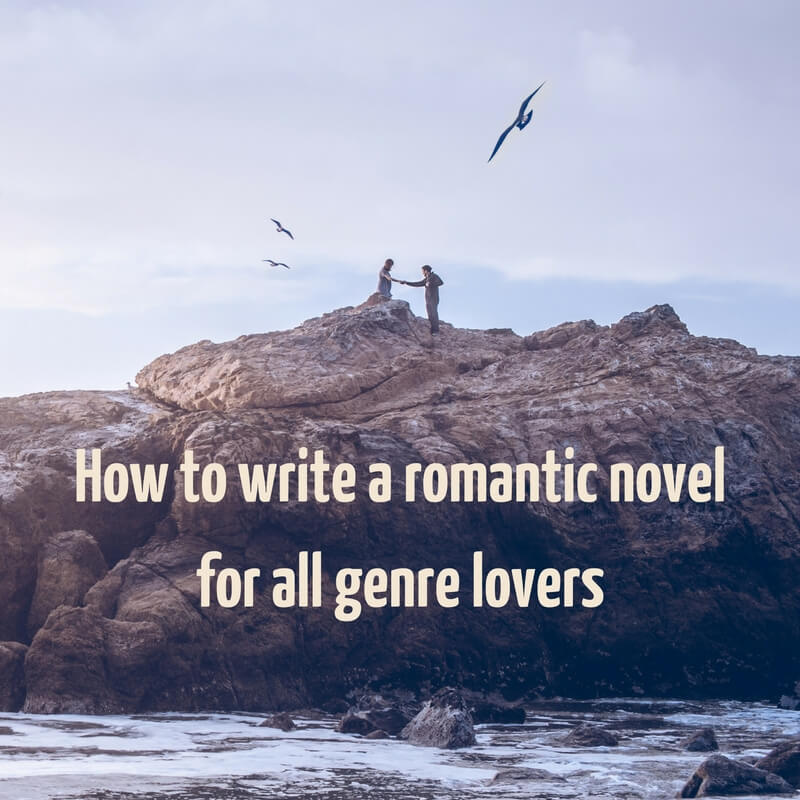There are many reasons to learn how to write a romantic novel. For one, Romance remains an extremely popular and even lucrative genre. In 2015, the Romance Writers of America shared statistics showing that romance books bring publishers and indie authors over $1.08 billion in sales annually. Here are 5 tips for writing a romantic book that will appeal to lovers of all genres:
First: The difference between a ‘Romance’ and a romantic novel
First we should distinguish between ‘Romance’ as a genre (with many subgenres of its own) and a ‘romantic novel’.
Romance as a genre has certain typical features. Romance-focused publishing houses such as Harlequin have novel series or categories, each with their own guidelines regarding story content. For example, Harlequin describes its ‘Harlequin Blaze’ category thus:
‘You like it hot! Harlequin Blaze stories sizzle with strong heroines and irresistible heroes playing the game of modern love and lust. They’re fun, sexy and always steamy.’
‘Harlequin Heartwarming’, on the other hand, takes a less sex-oriented approach:
‘You’ve got to have heart…. Harlequin Heartwarming celebrates wholesome, heartfelt relationships imbued with the traditional values so important to you: home, family, community and love.’
In a more generally romantic novel, you do not have to tick specific genre boxes. Twilight became a YA publishing phenomenon partly because it found a broader audience at the intersection of paranormal and romantic YA teen fiction.
A romantic novel can straddle multiple genres, and doesn’t necessarily have to include specific plot devices. Make sure your romantic novel appeals to the broadest possible audience by creating a strong, believable story. Here are 5 tips:
1. Draw out romantic tension
A romance novel that is all immediate, uncomplicated character attractions can feel clichéd. Die-hard romance lovers might accept a certain degree of predictability. Yet if you want to write a romantic novel with broad, cross-audience appeal, draw out romantic tension.
What is romantic tension? It’s the suspense created in the way two potential romantic partners orbit each other, before their union is certain. The relationship between Elizabeth Bennet and Mr Darcy in Jane Austen’s Pride and Prejudice is an excellent example:
On first meeting Mr Darcy, Elizabeth or Lizzie tells the character Charlotte, ‘I believe, ma’am, I may safely promise you never to dance with him.’ The feeling appears mutual, when Darcy shares similar apprehensions about Lizzie. The implication, however, that there could be occasion for the two characters to dance promises romantic tension. We already start to question how Lizzie and Darcy’s acquaintance will develop.
Popular romantic comedy TV shows such as New Girl or The Mindy Project build romantic tension by having primary characters embark on inconsequential flings, while growing closer to primary love interests. Often, the flings tick the obvious boxes of romantic attraction, while the primary romantic pair has a bickering, love-hate relationship. This is an effective way to build romantic tension because the box-ticking creates the contrast of a fleeting, easily-won intimacy. Meanwhile there is genuine affection and romantic tension brewing between the core romantic duo.
In a thriller or murder mystery, the question ‘who’ or ‘why’ is often the driving force of the story. Learning how to write a romantic novel means learning the importance of ‘when’. Romantic tension grows from the question, ‘When will the characters who have growing chemistry finally unite?’ Building this suspense is one way to develop an intriguing romantic story arc.
2. Show how your romantic duo is compatible as well as mismatched
The saying ‘opposites attract’ isn’t true for all scenarios. Sometimes couples seem almost identical in the ways their interests, temperaments, senses of humour and world views overlap. Yet friction and conflict create tension, suspense and a sense of narrative drive.
If the romantic leads of your novel are constantly gushing with affection this doesn’t read as believable because there are stumbling blocks and romantic incompatibilities that require work in most relationships.
When you are at the character creation stage (the Now Novel Story Builder will help you brainstorm), plan the ways characters match and don’t. The potential pairing in your story may share very similar life goals (for example both might have a thirst for adventure and travel together). Their ultimate goals could also be different yet complimentary. One, for example, might crave status and achievement. The other might prefer to play a supporting role, building the stability that helps the other achieve these goals. This same situation could be a source of conflict if both characters are more ambitious.
Whether your characters’ primary goals match up or don’t, make sure there are times in the story where they want different or competing things. This will create tension and conflict that together draw out romantic suspense. Avoiding conflict situations entirely creates a ‘happy people in happy land’ effect that could make your story feel hollow and predictable.
3. Give your romantic characters flaws that drive subplots
Great characters have flaws. Flaws create internal conflict – characters’ inner struggles – which in turn produce interesting dynamics between characters. In a romantic novel, the story arc can feel dominated by the developing relationship between the two primary characters. Add interest to the primary arc by using your main characters’ flaws as launching pads for subplots.
For example, in Charlotte Brontë’s classic romantic novel Jane Eyre, the love interest Rochester has a gruff and abrasive outward persona but a hidden tender quality. His flaw – his closed-off nature – is developed when Jane discovers a major, upsetting secret about him. The subplot of Rochester’s secret helps to explain why he has a guarded and intensely private persona.
4. Mine each stage of the romantic relationship for story
Learning how to write a romantic novel means learning how to mine each stage of romantic relationships for the key ingredients of story: ‘why’, ‘who’, ‘where’, ‘when’ and ‘what’. The stages of a romantic relationship are:
- First encounter: A meeting filled with the mystery of the unknown. People size each other up (and may have false perceptions as well as true intuitions about the other)
- Becoming familiar: People get to know each other. Some initial impressions are confirmed as true. Other perceptions might change. There is growing mutual liking through discovery. There might also be red flags that bring in doubt and uncertainty about romantic potential
- The first move: One or the other person makes a move (or both do, simultaneously) – there is an attempt to move beyond a platonic relationship status
- The honeymoon phase: The lovers see each other through rose-tinted glasses. The other can do no wrong, and both feel positive about the growing bond
- The post-honeymoon phase: Depending on whether or not the romantic union will last, people grow closer and more realistic about each other’s strengths and weaknesses. At the end of the book their relationship is happy and ‘to be continued’, or (given insurmountable obstacles) they part ways
When you write a romantic novel, it can help to step back and create a relationship arc summary and look at how your romantic duo develops. Is there a phase that’s perhaps lacking in suspense, friction or driving questions? Of course, these phases aren’t present in all relationships. Sometimes people jump straight to the first move on the first encounter. Think about the possible consequences of a leap like this. For example, when characters rush into a relationship, they may miss crucial warning signs that spell inevitable doom for a developing romantic partnership.
5. Show how secondary characters affect primary relationships
Even if two characters feel as though they live apart from the world in a rosy bubble, the truth is that romantic relationships take place in networks of other relations. Partners might find approval or disapproval from their significant others’ family and friends. There can be minor conflicts and frictions that create additional challenges.
When you plot your romantic story arc, include the ways secondary characters will impact on the course of main characters developing from friends into lovers. Merely bringing secondary characters into a primary romantic pairing’s bubble can create complications that produce tension and plot development.
Leo Tolstoy’s romantic epic Anna Karenina provides a good example. Anna’s affair with the young bachelor count Vronsky is complicated by societal moral scruples as well as Anna’s husband’s discovery of the affair. Anna’s illicit relationship with Vronksy takes place in a believable world where obligations to others affect relationships and characters’ romantic choices and possibilities. The tension and the questions driving the story arise largely out of the many ways romantic partnerships are seldom simply about two people.
Start fleshing out your characters with the Now Novel Story Builder. Get writing feedback so you can finish writing a satisfying romantic novel.
What has been your biggest challenge in learning how to write a romantic novel?




9 replies on “How to write a romantic novel for all genre lovers”
Some excellent points here! Food for thought, as I struggle along on my work-in-progess. Thanks for this post!
Thank you Frances, I’m glad you found these ideas helpful. All speed with your work-in-progress!
very helpful. I working on a SF novel, but there is a romantic relationship that slowly develops throughout. Previously, I’d been focused on getting other details right, so their arc was more “accidental.” This will help me clean it up and give it more impact. 😀
Glad to hear it! Sounds like an interesting mix of genre elements.
thank you for these ideas. You always post very useful advices. The challenge for me are the dialogues especially between my two main characters. I want them to be witty and fast paced and hinting and smart and sometimes, it just doesn’t come so naturally…
Thank you Katerina, I’m glad you found this useful. I’d suggest read widely and whenever you come across dialogue that fits this description for you (witty and fast-paced), copy a few lines of it out and take notes next to it. Ask, ‘How does the author achieve this effect? How long are the sentences? What punctuation do they use? Do the characters interrupt each other?’ For most writers a lot happens through hard work rather than naturally!
Thank you Bridget. Also I find yesterday’s tips for writing dialogue so helpful for me. I appreciate it!
Excellent ideas…Can I recommend another issue to address-“how to recommend to new characters to the storyline”
Great suggestion, Christoforos. Character introductions are important as first impressions.